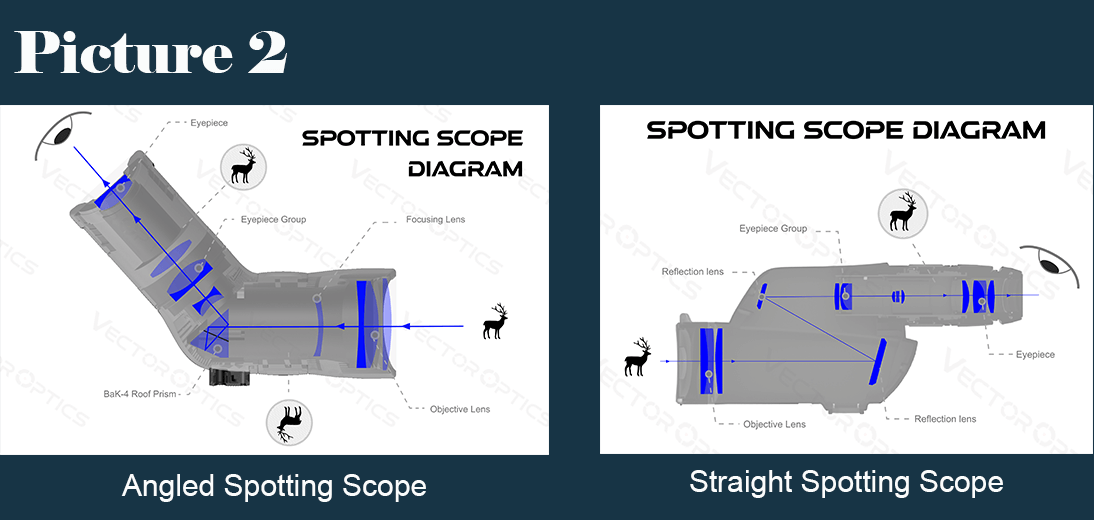Academy
2023-08-22Evelyn: Hi Stephen, I was thinking about getting a new spotting scope. But I'm unsure about whether to go for an angled or straight scope. Can you help me out?
Stephen: Hi Evelyn, sure thing. Before we start the discussion, I have one simple question for you: do you know what is a spotting scope and how it works?
Evelyn: Yes,a spotting scope is a type of telescope that is used for terrestrial observation. It works by using a combination of lenses and prisms to magnify distant objects, and it is typically mounted on a tripod for stability and ease of use.
Stephen: Yes, spotting scopes are typically used for bird watching, hunting, and other outdoor activities where it is necessary to see objects that are far away. They feature high magnification(common ones are 12x-40x, 15x-40x, 20x-60x, 25-75x etc.,), large objective lens diameter and built-in prism lens(Porro prism or Roof prism). Check out Picture 1 for reference.

Evelyn: I see. And what’s the difference between an angled spotting scope and a straight spotting scope?
Stephen: Well, in terms of the appearance and inner construction, the key difference is the straight eyepiece or the angled eyepiece. An angled spotting scope has an angled eyepiece, which is set at a 45-degree angle to the scope body. A straight spotting scope, on the other hand, has a straight eyepiece that is in line with the scope body. Check out Picture 2 for reference.

Evelyn: Got you! And how to choose between the angled spotting scope and the straight spotting scope?
Stephen: That depends on different usage and different situations. Let’s first talk about the pros and cons of the two spotting scope, so that you’ll know how to choose properly.
Evelyn: Yes, let’s start with straight spotting scopes. What are the pros and cons?
Stephen: Well, if you are new to spotting scope, and want to use a spotting scope to look at animals on the ground, then the straight spotting scope would be a better choice. Straight spotting scopes are also suitable for viewing in narrow spaces such as inside a vehicle. If you want to use it for prolonged observation, you can adjust the tripod height to be level with your eyes, which is a less fatiguing posture. However, it can be hard to use when looking up at an angle. And it requires a higher tripod height to achieve the same viewing height as an angled spotting scope.
Evelyn: That's a good point. And what about angled spotting scope?
Stephen: The angled spotting scope is more comfortable to use when looking up at an angle, it allows for a lower tripod height, which can be more stable in windy conditions, or more comfortable to use from a seated position. The eyepiece can be adjusted for different heights, thus the angled spotting scopes can be easier to share with others. However, they can be more difficult to use for people who are new to spotting scopes, and can be a little difficult to glass at extreme downhill angles.
Evelyn: I see. So the pros and cons of the two spotting scopes are as below, check it out.

Stephen: Yes, that’s correct. Either one that you choose, make sure the spotting scope is compatible with a tripod, which will help you stabilize the image and reduce shakiness.
Evelyn: Got it. And what about different use scenarios? Are there any situations where one type of scope is better than the other?
Stephen: For birdwatching, an angled scope may be better if you're looking up into tall trees or at birds that are perched high up on a branch. The angled design can help you get a better view without having to strain your neck or back. However, if you're mostly viewing from a seated position, a straight scope might be more comfortable and easier to use. It all comes down to personal preference and the type of birdwatching you plan to do.
Evelyn: Thanks for all the info, Stephen. I think I have a better idea of what to look for now.
Stephen: No problem, happy to help. Let me know if you have any more questions or if you need any more advice!
Join our Facebook community to know more about Vector Optics!
